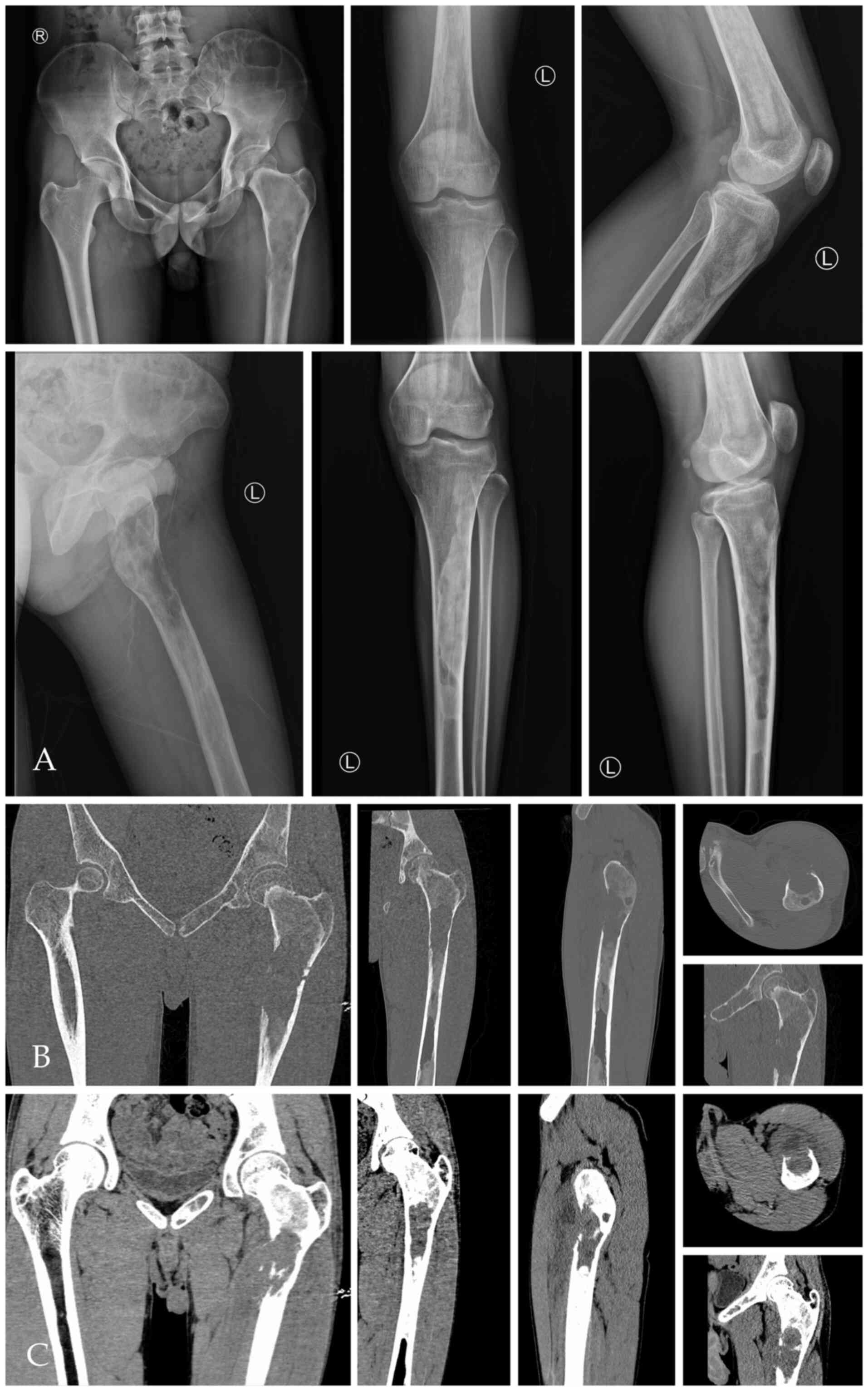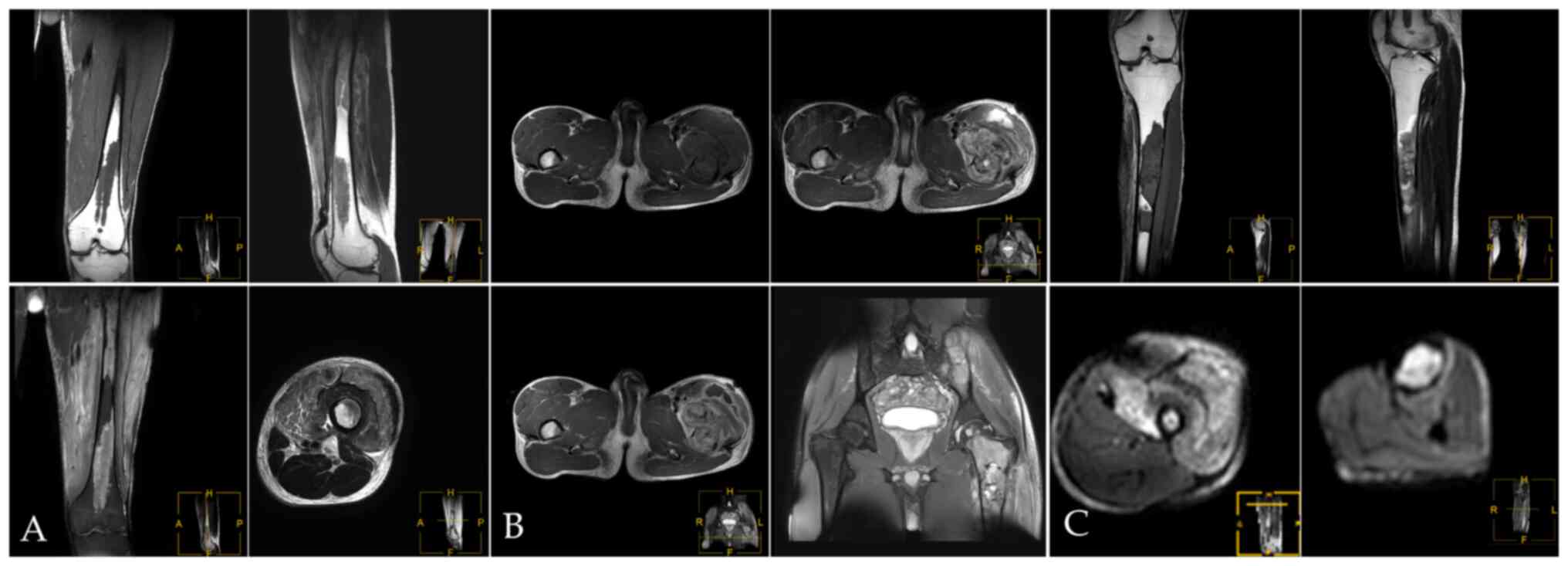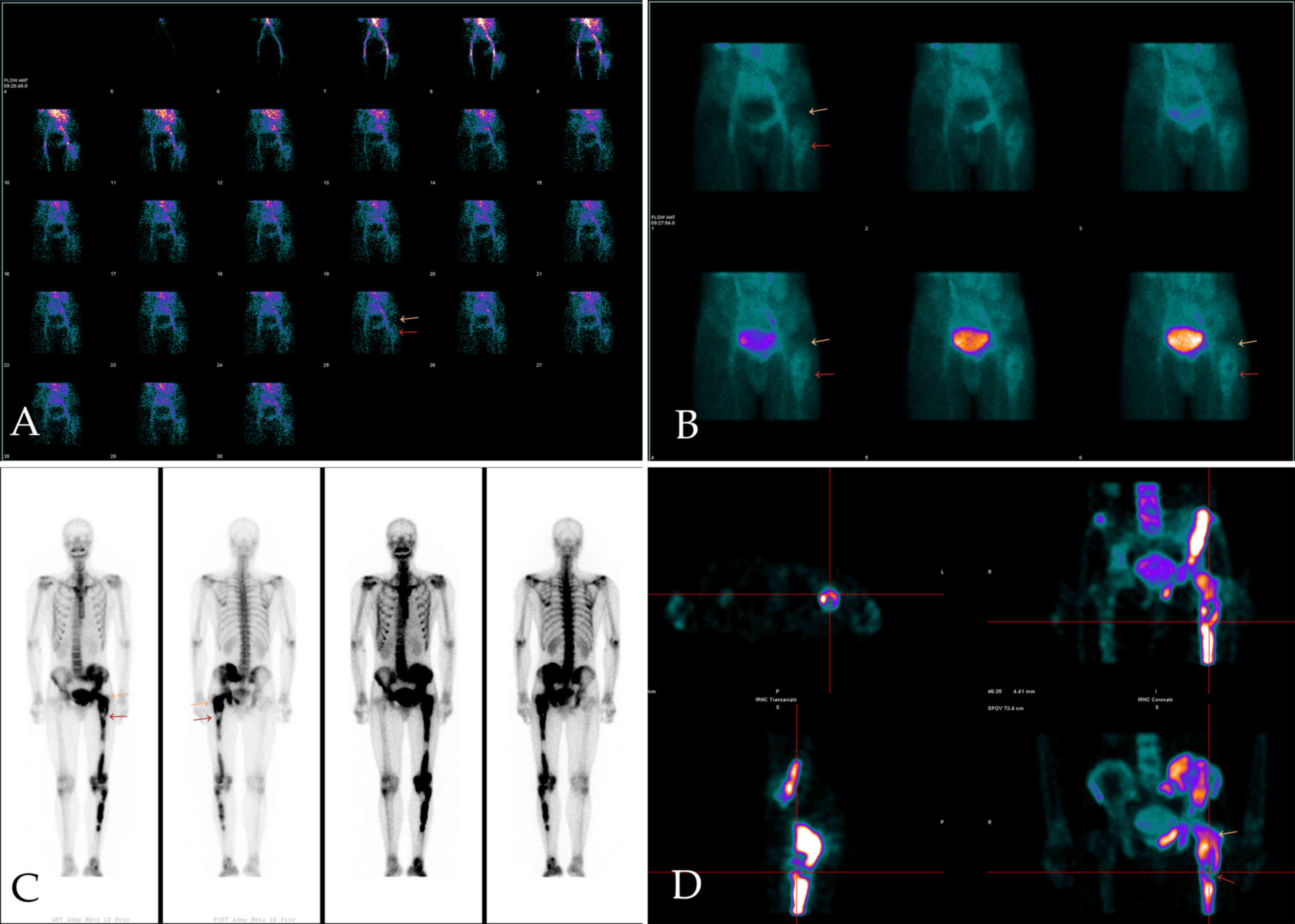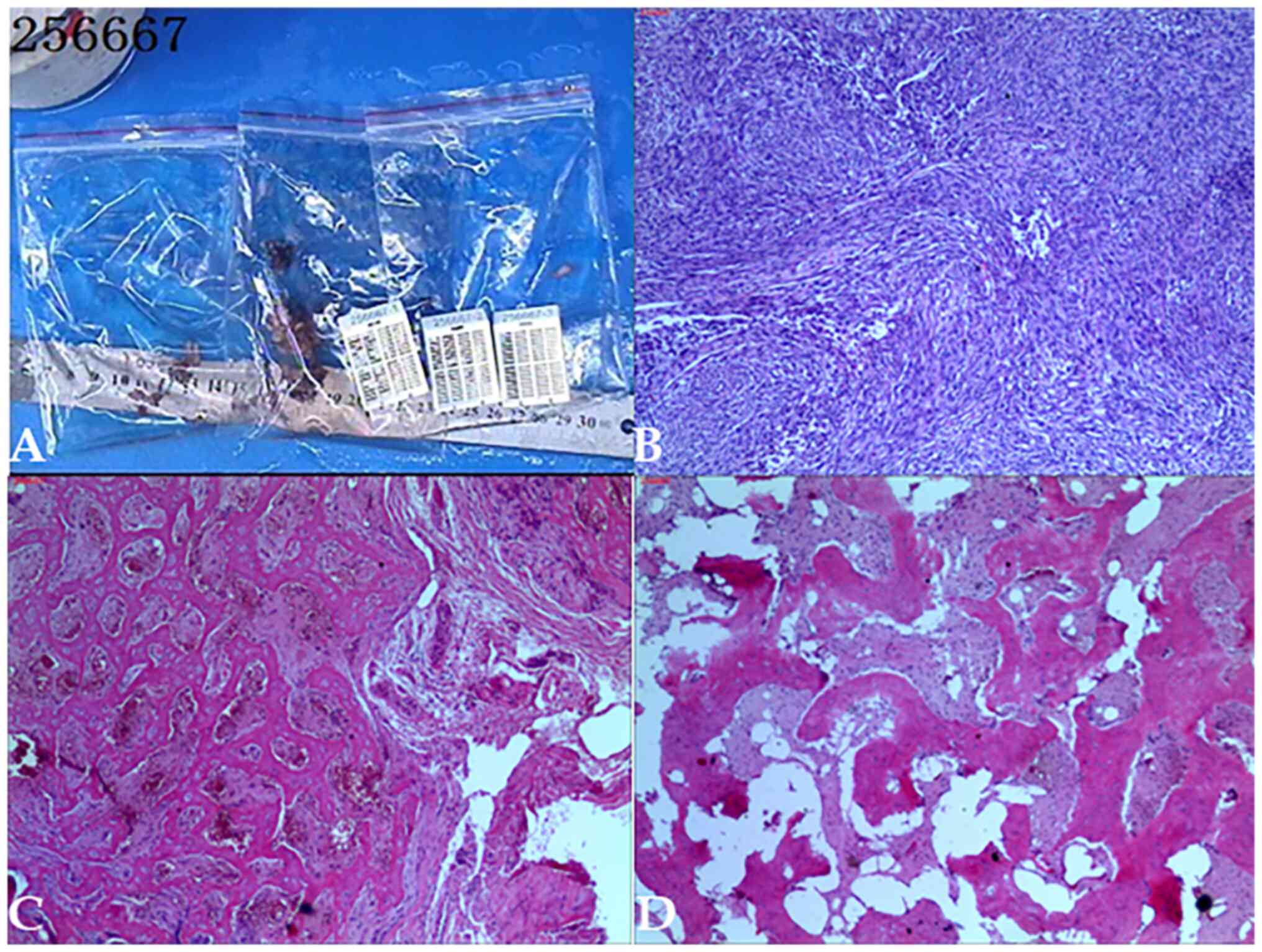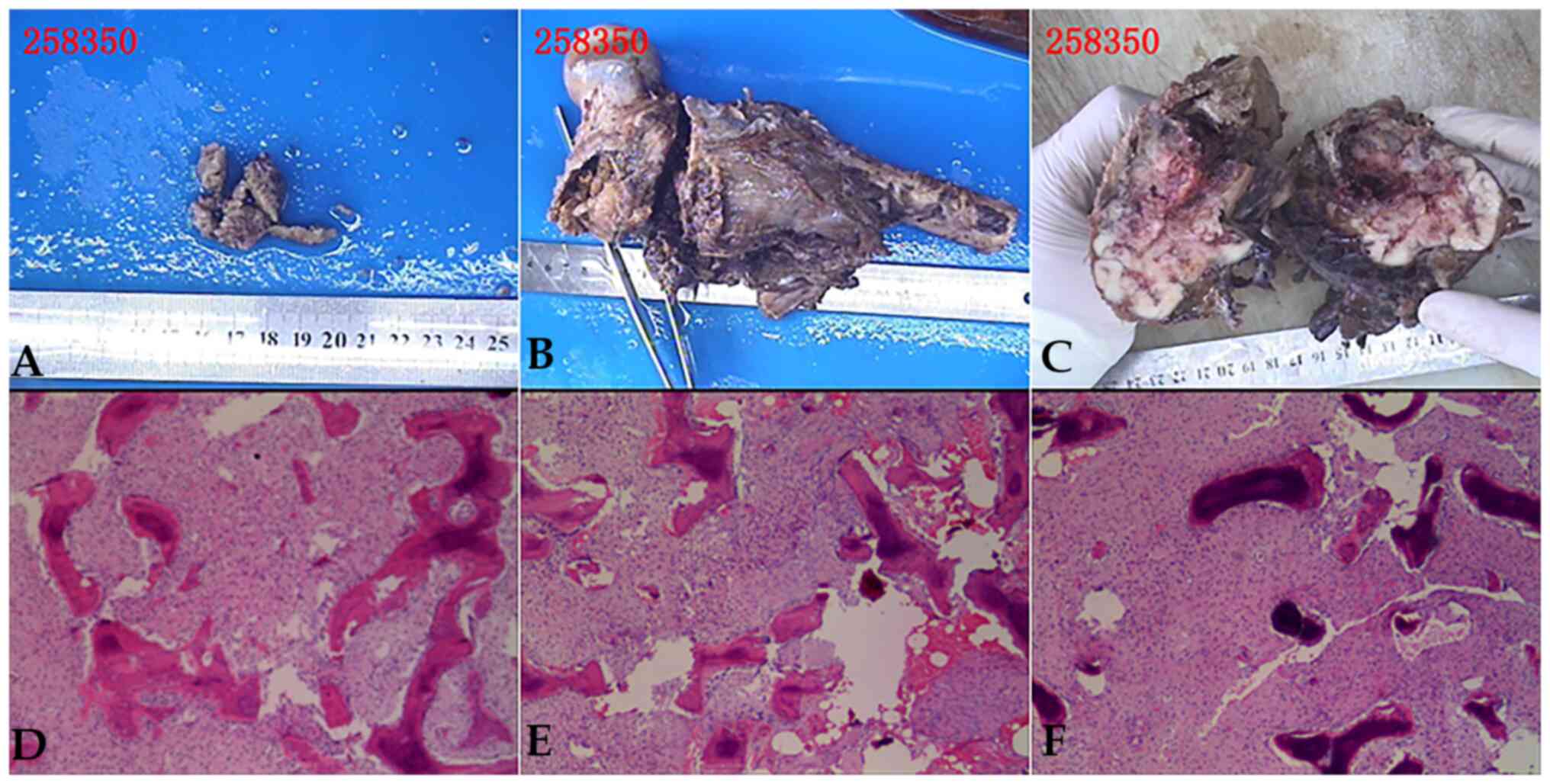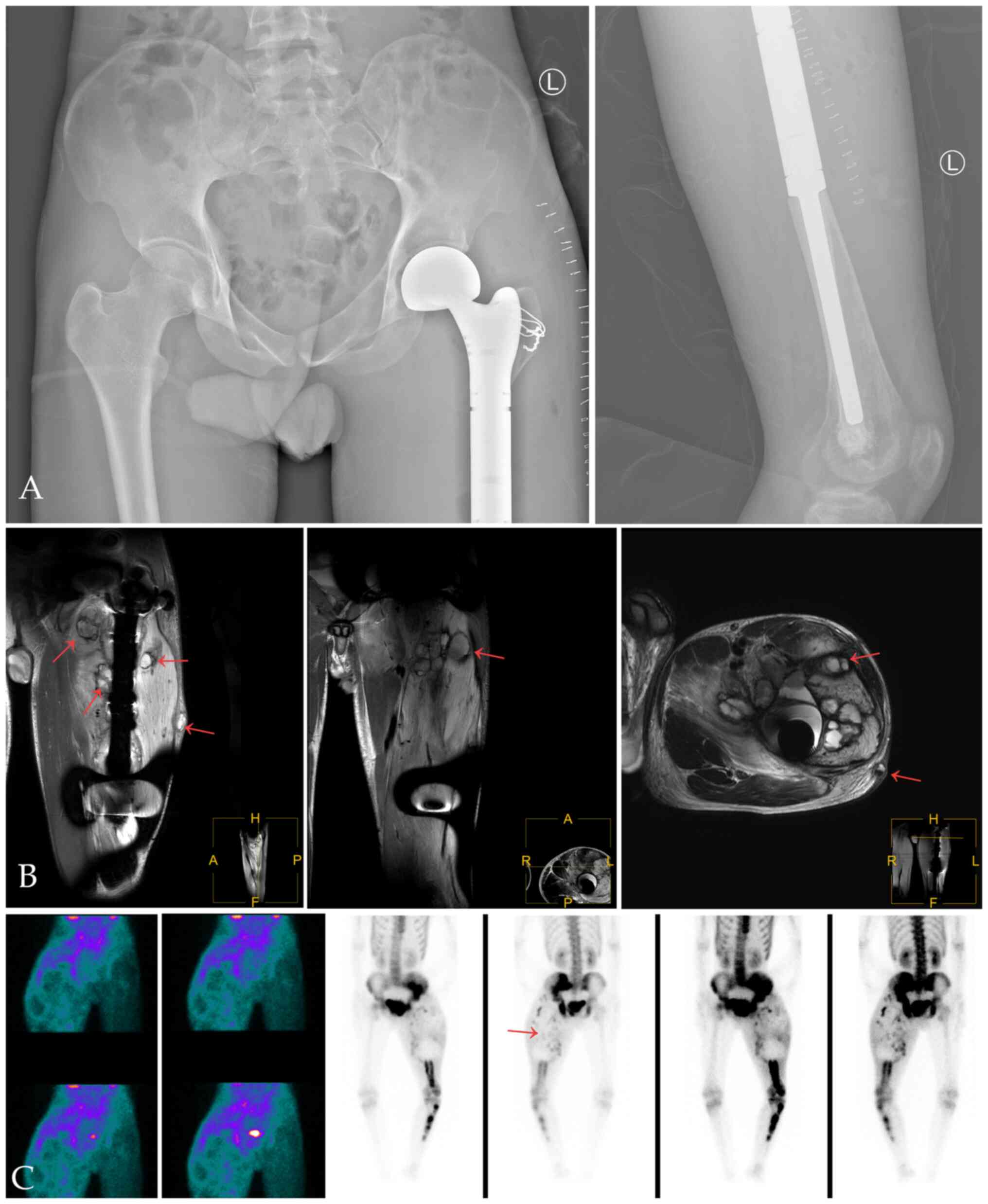Multimodal imaging diagnosis for bone fibrous dysplasia malignant transformation: A case report
- Authors:
- Published online on: September 1, 2023 https://doi.org/10.3892/br.2023.1655
- Article Number: 73
-
Copyright: © Lu et al. This is an open access article distributed under the terms of Creative Commons Attribution License.
Abstract
Introduction
Fibrous dysplasia of bone (FDB) is a non-malignant fibro-osseous lesion that accounts for 5-7% of all benign bone tumors (1), with a low malignant transformation or local aggressive form rate (2,3). FDB may involve single bone (monostotic disease) or multiple bones (polyostotic disease) (3,4). The main pathological changes of FDB are that normal bone architecture and bone marrow are replaced by a large amount of proliferative fibrous tissue, in which there are ill-structured trabeculae (5). A variety of causative factors, including repeated surgical treatment, artificial limb implantation and radiotherapy, are potential factors to stimulate the malignant transformation of FDB (6,7). The age of the patient is another factor that also correlates to sarcomatous transformation (8). Poorly defined margins, cortical destruction and soft tissue involvement are features on imaging of malignant transformation; however, these features overlap with those of locally aggressive FDB (2,3). Therefore, the diagnosis of malignant transformation of FDB is a clinical challenge. However, the prognosis of patients with FDB malignant transformation is poor as, even if they receive preoperative and/or postoperative chemotherapy and subsequent extensive resection, distant metastasis and death are inevitable (9). Osteosarcoma accounts for more than half of all the malignant transformations of FDB, followed by fibrosarcoma and chondrosarcoma, secondary angiosarcomas and malignant fibrous histiocytoma (4,10). The present case study describes a rare case of FDB that was associated with malignant sarcomatous transformation.
Case presentation
Presentation
A 23-year-old man was referred to the Department of Orthopedics, The Third Affiliated Hospital of Guangzhou Medical University in May 2018 with persistent pain in the left hip for 6 months that had been aggravated for 1 week.
History of present illness
The present patient presented with persistent pain in the left hip without obvious inducement that started 6 months before the hospital visit. The pain was obvious in squatting and standing up. The patient was initially admitted to a local hospital, where an X-ray and MRI investigation showed a central intramedullary expansile lytic lesion with a wide zone of transition at the proximal metadiaphysis of the left femur, but the clinical diagnosis was inconclusive, and the patient did not receive any special treatment. On 14 May 2018, the patient was referred to the Department of Orthopedics, the Third Affiliated Hospital of Guangzhou Medical University for further diagnostics and treatment for aggravated pain in the left hip. After admission, multimodal imaging including X-ray, CT, MRI and Technetium 99m-methyl diphosphonate (99mTc-MDP) three-phase bone imaging were performed. It was agreed that these images were consistent with FDB with malignant transformation after a multidisciplinary team discussion. To make a definite diagnosis, the patient underwent a left femur biopsy 4 days after referral to hospital, followed by left femur surgical biopsy and a left tibia percutaneous biopsy 10 days later. The pathological analysis showed that the lesions were consistent with malignant mesenchymal tumors of the left femur and it was concluded that they were malignant fibrous histiocytoma of the bone and osteofibrosarcoma. The patient underwent chemotherapy, left femur tumor segment resection and hip joint replacement on 39 days after referral to our hospital. The surgical and postoperative pathological findings confirmed fibrosarcoma of the bone with extraosseous soft tissue involvement.
History of past illness
The patient had no relevant previous medical history, such as trauma, falls or tumors.
Personal and family history
The patient had no tumor-related family history. The patient had no history of contact with carcinogenic chemical, radioactive or toxic substances, and no history of drug abuse, smoking and drinking.
Physical examination
There was no obvious deformity of the left thigh and hip, and no obvious skin redness, swelling and ulceration. Local skin temperature did not increase and the patient had good skin sensation, but obvious local tenderness in the left hip, and longitudinal percussion pain in the left lower limb.
Laboratory examinations
Laboratory tests revealed alkaline phosphatase 239 U/l (reference range, 45-125 U/l), erythrocyte sedimentation rate 68 mm/h (reference range, <15 mm/h), C-reactive protein 135.3 ng/l (reference range, <10 ng/l), total neutrophil count 7.74x109/l (reference range, 2.0-6.9x109/l) and neutrophil ratio 82.2% (reference range, 37.0-80.0%).
Imaging and histological examinations
X-ray and CT of the left femur showed abnormal density of the left femur and the bone marrow cavity of the left hip, upper tibia and sacrum, and bone destruction of the anteromedial cortex of the left femur and formation of surrounding soft tissue masses (Fig. 1A-C). The possibility of malignancy was considered. MRI showed multiple bone destruction areas occupying most of the space of the marrow cavity with hypointensity on T1-weight imaging (T1WI), heterogeneous enhancement on contrast-enhanced T1WI, heterogeneous iso- and hyper-intensity on T2WI, and heterogeneous signal intensity on T2-weight spectral attenuated inversion recovery (T2W-SPAIR).
These features indicated local bone destruction, swelling of surrounding soft tissue and soft tissue invasion (Fig. 2A and B). In the upper left femur, an irregular mass was seen in front of the upper left femur, which broke through the cortex and protruded into the surrounding soft tissue (Fig. 2C). 99mTc-MDP three-phase bone imaging was recommended to confirm the blood supply and abnormal uptake of 99mTc-MDP. The areas of bone and marrow surrounding the greater trochanter and the neck of the left femur showed increased blood perfusion on the perfusion and blood pool phase, while bone marrow destruction areas in MRI showed higher amounts of blood perfusion in the upper femur (below the greater trochanter) (Fig. 3A and B). However, the levels of tracer uptake of the two areas were reversed in the delayed phase and were clearer on tomography. The other tracer uptake lesions in the left pelvic and lower limb bone corresponded to an ill-defined radiolucent lesion on X-ray (Fig. 3C and D).
After discussion, it was agreed that this was consistent with malignant mesenchymal tumors. To obtain a definite diagnosis, the patient underwent left femoral and tibial percutaneous biopsy (Fig. 4) and left femoral surgical biopsy (Fig. 5). The pathological analysis (Fig. 5) showed that the lesions were consistent with malignant mesenchymal tumors of the left femur and concluded that they were malignant fibrous histiocytoma of the bone and osteofibrosarcoma. Postoperative histological examination (Fig. 6) confirmed bone tumor tissue and a distal femoral medullary cavity consistent with fibrosarcoma.
Final diagnosis
The final diagnosis was made following biopsy and segmental resection, based on a histopathological examination of the resected tumor. The left femur tumor, which destroyed the diaphysis and invaded the soft tissue outside the bone, was confirmed to be osteofibrosarcoma (Figs. 5B and 6). The tumor tissue in the left upper-middle tibia was consistent with fibrous dysplasia without malignant transformation (Fig. 5C and D).
Treatment and follow-up
After the final diagnosis, the patient received chemotherapy with epirubicin 50 mg + vincristine 2 mg + methotrexate 10 g, and the process was successful. Subsequently, 2 weeks later (22 June 2018), left femur tumor segment resection and hip replacement were performed (Fig. 7A), and postoperative histological examination confirmed that the bone tumor tissue and distal femoral medullary cavity were consistent with fibrosarcoma. In September 2018, ~3 months after the operation, a surgical biopsy was performed on a mass resected from the surface of the left thigh because of suspicion of local tumor recurrence (Fig. 7B and C). Pathological examination showed recurrence of the left femur fibrosarcoma, and surgical resection and symptomatic treatment were performed again. In March 2019, another operation of the left hip disarticulation was scheduled for tumor resection following further local recurrence. The operation was successful without obvious postoperative acute complications.
Outcome
The last operation was performed in March 2019. Subsequently, 1 month later, the condition of the patient deteriorated and the patient died of cachexia caused by extensive metastasis in April 2019.
Discussion
FDB is commonly found in long bones (proximal femur and tibia), and can be divided into single or multiple bone types (11). It is mostly confined to one limb, but other anatomical sites, such as the jaws, craniofacial bones and sacrum can be also involved (12-14). In the early stage of FDB, patients present with no symptoms, but local aggression to the periosteum or increased bone marrow pressure can cause discomfort, bone pain and movement disorders. Serious cases can lead to stress fracture or pathological fracture (15). When localized osteolytic destruction, soft tissue extension, sudden aggravation of pain or pathological fractures are found, the possibility of malignant transformation should be suspected (15,16). However, the treatment and prognosis of malignant transformation are markedly different from locally aggressive FDB. In the present case, the lesions in the left limb were polyostotic and extensive, including the tibia and femur, and involved the ipsilateral pelvis, with further extraosseous tissue invasion. The present case study aimed to find the features of malignant transformation of FDB in multimodal imaging.
FDB is most often discovered based on radiographic evidence (1), and radiographic classification for fibrous dysplasia is beneficial to guide treatment planning and evaluation of the effects of surgery (17). It is recommended that patients with FDB should undergo radiological examinations before pathological biopsy and clinical treatment because malignant transformation and local aggression can usually be distinguished from non-aggressive FDB based on imaging findings (18).
The specific findings of X-ray and CT depend on the degree of fibrous tissue hyperplasia in the lesion and the content of new and mature bone trabeculae. When the lesion is mainly fibrous tissue, it appears as a cystic clear area. When the lesions are new bone trabeculae and the fibrous tissue of hyperplasia is woven into the bone, it shows a ground glass appearance (2,19), whilst when the lesion area is mature bone tissue, it shows a high-density strip and patchy ossification shadowing. The radiographic features of malignant transformation or local aggression of FDB include poorly defined margins, mineralized osteolytic lesions, cortical destruction and extension into soft tissue (2,15). MRI findings are related to the amount of fibrous tissue, whether there is hemorrhage, cartilaginous island or residual bone marrow fat. FDB is usually featured with homogeneous T1WI hypo-intensity and a surrounding sclerotic rim T1WI and T2WI hypo-intensity (13). T1WI and T2WI hyperintensity is observed in the corresponding areas when cystic degeneration, hemorrhage, cartilage island or residual bone marrow fat are present in the lesion. If the lesion capsule is completely depleted, T1WI hypo-intensity and T2WI hyperintensity are observed (20).
MRI can show cortical destruction and soft tissue extension for locally aggressive FDB which overlaps with malignant transformation (15). A prominent hyper-vascularized soft tissue mass extending from bone may be helpful in the differential diagnosis. 99mTc-MDP single photon emission computed tomography (SPECT) directly reflects the calcium/phosphate metabolism of bone tissue and indicates the functionality and number of osteoblasts. The three-phase bone imaging can be used to observe the blood supply and the active state of bone metabolism, which is helpful for the differential diagnosis of benign and malignant bone diseases (21). FDB has distinctive characteristics on 99mTc-MDP SPECT/CT; 85.7% of cases show moderate or high radiotracer uptake on delayed whole-body bone scintigraphy (WBS) (21). This helps identify FDB as the SPECT/CT shows features of ground-glass opacity and expansion in the areas of high radiotracer uptake while without soft tissue occupying lesions in bone marrow. However, a high tracer uptake can be seen on locally aggressive FDB because its tissue type is composed of trabeculae of immature bone and fibers stroma (11). Comparatively low tracer uptake in the delayed phase but high blood perfusion in the perfusion phase and the blood pool phase is considered to have a malignant transformation diagnosis (21,22). In the present case study, the three-phase bone imaging showed that the blood perfusion and blood pool were increased, and the abundant blood perfusion was indicative of malignancy. Delayed phase findings indicated that there were fewer osteoblasts and calcium/phosphate but more interstitial tissue. The corresponding lesions were confirmed through finer anatomic proximity on MRI.
All imaging examinations have their unique functions. The degree of X-ray radiographic density is directly proportional to the degree of mineralization and brighter areas reflect predominantly fibrous zones, which can help with earlier FDB detection. SPECT/CT is important for assessing local function and microscopic components. MRI is an excellent method for assessing cases of complex fibrous dysplasia, reflecting the variable tissue components. CT complements and enhances the interpretation of MRI of bone lesions, especially in cases where MRI shows enhancement that is suspicious of a malignant neoplasm (19,23). However, the presentation of those features is often non-specific, and it is recommended to use multimodal imaging that can show the anatomy, blood supply, molecular components and metabolism of the lesion at the same time to improve the diagnostic accuracy of FDB and its malignant transformation. In actual clinical practice, other clinical data need to be considered to make a comprehensive judgment. Consideration of potential factors such as age and history of surgery is important. It is necessary to combine relevant laboratory indicators, including serum alkaline phosphatase. Wang et al showed that FDB with high serum alkaline phosphatase level has a tendency to progress to severe disease (24). In the present case study, alkaline phosphatase was ~2-fold the upper limit of the normal range, which was significantly higher compared with the normal level. A limitation of the present case study is the lack of imaging data before the malignant transformation.
Although biopsy is often the gold standard for diagnosis, multimodal imaging is useful to define the scope of the lesion and help to guide treatment planning. Comprehensive analysis of multimodal images may improve the detection rate and diagnostic accuracy of local FDB aggressiveness and its malignant transformation, thus guiding clinical diagnosis and treatment decision-making.
Acknowledgements
Not applicable.
Funding
Funding: No funding was received.
Availability of data and materials
The datasets used and/or analyzed during the current study are available from the corresponding author on reasonable request.
Authors' contributions
JL, MK, XY and JZ confirm the authenticity of all the raw data. JL, MK and JZ contributed to the conception of the study. JL and MK were responsible for writing the original draft, reviewing and editing the manuscript. XY, JL, MK were responsible for acquisition of clinical data. XY and JZ were responsible for critical revision of the manuscript and the analysis and interpretation of the data. All authors read and approved the final version of the manuscript.
Ethics approval and consent to participate
This study passed ethical review by the Ethics Committee of the Third Affiliated Hospital of Guangzhou Medical University. All the data used were collected from the Third Affiliated Hospital of Guangzhou Medical University with the consent of the patient.
Patient consent for publication
All the test results, imaging images, and their publication were obtained with written consent from the patient.
Competing interests
The authors declare that they have no competing interests.
References
|
Hakim DN, Pelly T, Kulendran M and Caris JA: Benign tumours of the bone: A review. J Bone Oncol. 4:37–41. 2015.PubMed/NCBI View Article : Google Scholar | |
|
Qu N, Yao WW, Cui X and Zhang H: Malignant transformation in monostotic fibrous dysplasia: Clinical features, imaging features, outcomes in 10 patients, and review. Medicine (Baltimore). 94(e369)2015.PubMed/NCBI View Article : Google Scholar | |
|
Martini M, Klausing A, Heim N, Fischer HP, Sommer A and Reich RH: Fibrous dysplasia imitating malignancy. J Craniomaxillofac Surg. 46:1313–1319. 2018.PubMed/NCBI View Article : Google Scholar | |
|
Riddle ND and Bui MM: Fibrous Dysplasia. Arch Pathol Lab Med. 137:134–138. 2013.PubMed/NCBI View Article : Google Scholar | |
|
Zoccali C, Attala D, Rossi B, Zoccali G and Ferraresi V: Fibrous dysplasia: An unusual case of a very aggressive form with costo-vertebral joint destruction and invasion of the contralateral D7 vertebral body. Skeletal Radiol. 47:1571–1576. 2018.PubMed/NCBI View Article : Google Scholar | |
|
Ottaviani G and Jaffe N: The epidemiology of osteosarcoma. Cancer Treat Res. 152:3–13. 2009.PubMed/NCBI View Article : Google Scholar | |
|
Ruggieri P, Sim FH, Bond JR and Unni KK: Malignancies in fibrous dysplasia. Cancer. 73:1411–1424. 1994.PubMed/NCBI View Article : Google Scholar | |
|
Hoshi M, Matsumoto S, Manabe J, Tanizawa T, Shigemitsu T, Izawa N, Takeuchi K and Kawaguchi N: Malignant change secondary to fibrous dysplasia. Int J Clin Oncol. 11:229–235. 2006.PubMed/NCBI View Article : Google Scholar | |
|
Kim HG, Baek JH and Na K: Osteosarcoma arising in fibrous dysplasia of the long bone: Characteristic images and molecular profiles. Diagnostics (Basel). 12(1622)2022.PubMed/NCBI View Article : Google Scholar | |
|
Su XY, Sun WP, Yuan JQ, Li LX, Jiang ZM and Zhang HZ: Sarcoma arising in fibrous dysplasia: A clinicopathological analysis. Zhonghua Bing Li Xue Za Zhi. 51:733–737. 2022.PubMed/NCBI View Article : Google Scholar : (In Chinese). | |
|
DiCaprio MR and Enneking WF: Fibrous dysplasia. Pathophysiology, evaluation, and treatment. J Bone Joint Surg Am. 87:1848–1864. 2005.PubMed/NCBI View Article : Google Scholar | |
|
Singh V, Gupta K and Salunke P: Monostotic craniofacial fibrous dysplasia: Report of two cases with interesting histology. Autops Case Rep. 9(e2018092)2019.PubMed/NCBI View Article : Google Scholar | |
|
Liu XX, Xin X, Yan YH and Ma XW: Imaging characteristics of a rare case of monostotic fibrous dysplasia of the sacrum: A case report. World J Clin Cases. 9:1111–1118. 2021.PubMed/NCBI View Article : Google Scholar | |
|
Davidova LA, Bhattacharyya I, Islam MN, Cohen DM and Fitzpatrick SG: An analysis of clinical and histopathologic features of fibrous dysplasia of the jaws: A series of 40 cases and review of literature. Head Neck Patho. 14:353–361. 2020.PubMed/NCBI View Article : Google Scholar | |
|
Muthusamy S, Subhawong T, Conway SA and Temple HT: Locally aggressive fibrous dysplasia mimicking malignancy: A report of four cases and review of the literature. Clin Orthop Relat Res. 473:742–750. 2015.PubMed/NCBI View Article : Google Scholar | |
|
Ogul H and Keskin E: Locally aggressive fibrous dysplasia mimicking malign calvarial lesion. J Craniofac Surg. 29:e318–e319. 2018.PubMed/NCBI View Article : Google Scholar | |
|
Wang Y, Luo Y, Min L, Zhou Y, Wang J, Zhang Y, Lu M, Duan H and Tu C: The West China Hospital radiographic classification for fibrous dysplasia in femur and adjacent bones: A retrospective analysis of 205 patients. Orthop Surg. 14:2096–2108. 2022.PubMed/NCBI View Article : Google Scholar | |
|
Pozzessere C, Cicone F, Barberio P, Papa A, Coppolino G, Biagini R and Cascini GL: Cross-sectional evaluation of FGD-avid polyostotic fibrous dysplasia: MRI, CT and PET/MRI findings. Eur J Hybrid Imaging. 6(19)2022.PubMed/NCBI View Article : Google Scholar | |
|
Atalar MH, Salk I, Savas R, Uysal IO and Egilmez H: CT and MR imaging in a large series of patients with craniofacial fibrous dysplasia. Pol J Radiol. 80:232–240. 2015.PubMed/NCBI View Article : Google Scholar | |
|
Kinnunen AR, Sironen R and Sipola P: Magnetic resonance imaging characteristics in patients with histopathologically proven fibrous dysplasia-a systematic review. Skeletal Radiol. 49:837–845. 2020.PubMed/NCBI View Article : Google Scholar | |
|
Zhang LQ, He Q, Li W and Zhang RS: The value of 99mTc-methylene diphosphonate single photon emission computed tomography/computed tomography in diagnosis of fibrous dysplasia. BMC Med Imaging. 17(46)2017.PubMed/NCBI View Article : Google Scholar | |
|
Wei WJ, Sun ZK, Shen CT, Zhang XY, Tang J, Song HJ, Qiu ZL and Luo QY: Value of 99mTc-MDP SPECT/CT and 18F-FDG PET/CT scanning in the evaluation of malignantly transformed fibrous dysplasia. Am J Nucl Med Mol Imaging. 7:92–104. 2017.PubMed/NCBI | |
|
Gokce E and Beyhan M: Radiological imaging findings of craniofacial fibrous dysplasia. Turk Neurosurg. 30:799–807. 2020.PubMed/NCBI View Article : Google Scholar | |
|
Wang J, Du Z, Li D, Yang R, Tang X, Yan T and Guo W: Increasing serum alkaline phosphatase is associated with bone deformity progression for patients with polyostotic fibrous dysplasia. J Orthop Surg Res. 15(583)2020.PubMed/NCBI View Article : Google Scholar |



